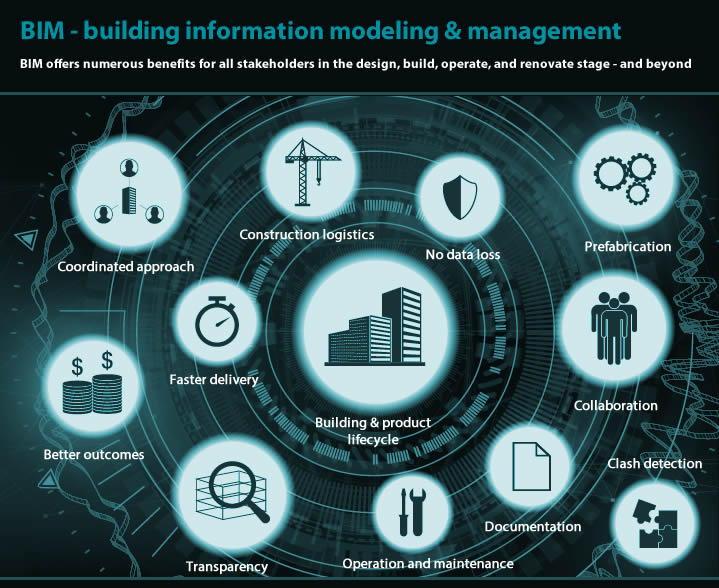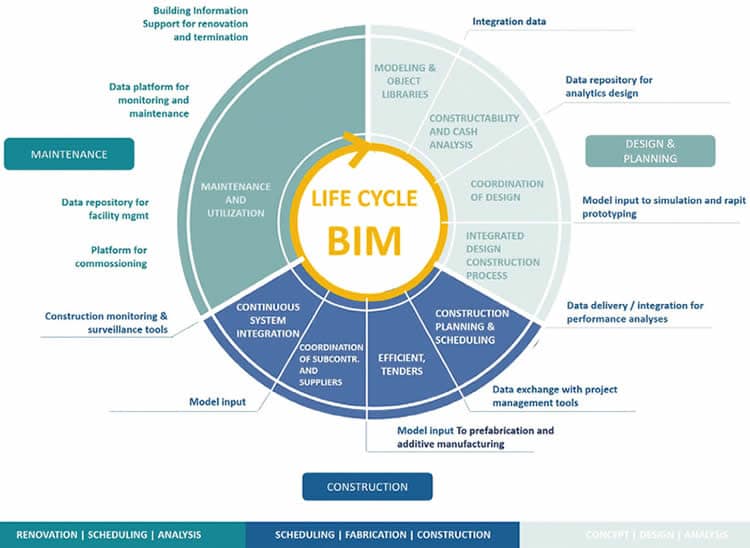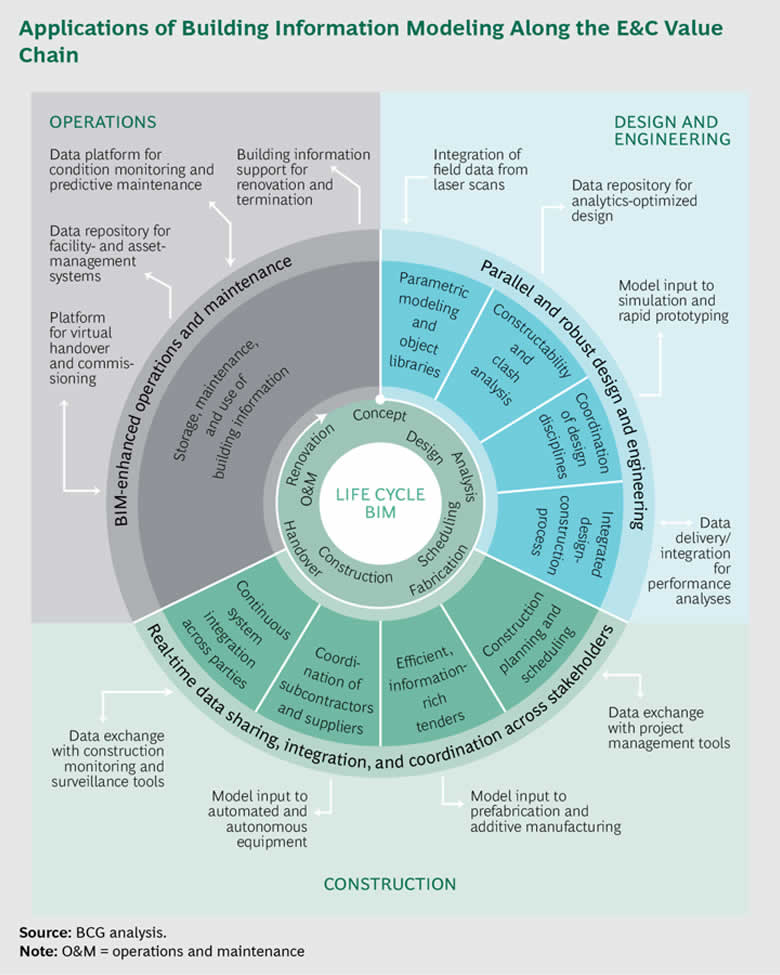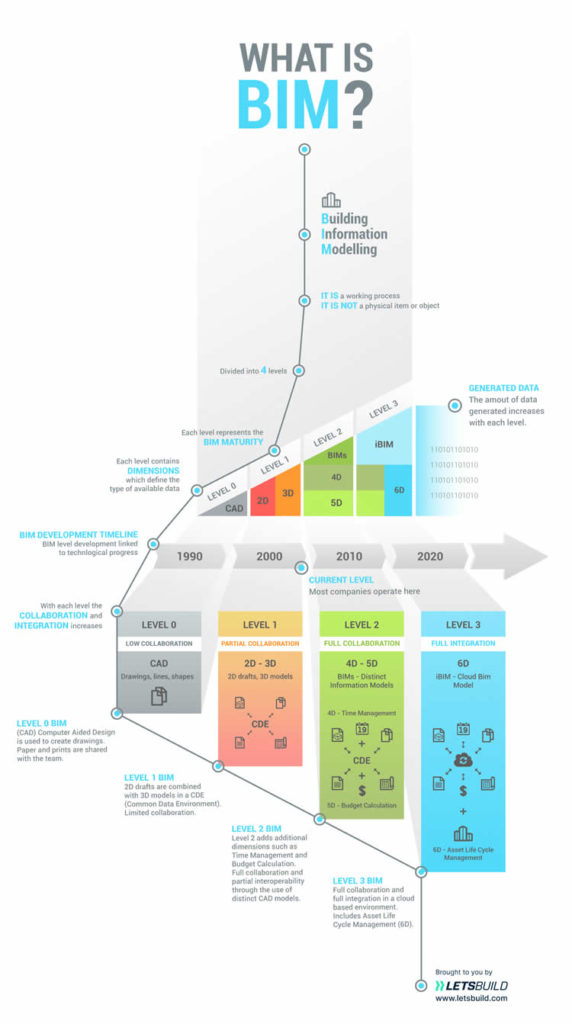BIM stands for Building Information Model, Building Information Modeling, and Building Information Management. While most people who know BIM will refer to Building Information Modeling or the ‘Model’ dimension, the ‘Management’ part is at least as important.
BIM enables various building partners and stakeholders in infrastructure projects to collaborate better with digital building/construction/infrastructure models.
Using different applications, technologies, workflows, and processes in a managed, optimized and predefined way in a project where BIM is utilized, a digital 3D building model (BIM as ‘the model’) is available for all partners. It is a virtual representation of the construction, linking geometry and information.

The parties working with such a model are traditionally companies/professionals who are active in the AEC industry: architecture, engineering, and construction. The various partners from each of these three segments collaborate on delivering buildings and infrastructure for their clients. Traditionally they did so in a rather sequential way without too many modern data and information collaboration methods.
Collaboration by the various stakeholders across the life cyle of a facility (design and planning, construction, maintenance and utilization, renovation, and termination) in an information-intensive way is precisely one of the premises of BIM.
A basic premise of BIM is collaboration by different stakeholders at different phases of the life cycle of a facility to insert, extract, update or modify information in the BIM to support and reflect the roles of that stakeholder. (NBIMS-US)
Since in BIM, all of them are invited (or mandated) to work with the same model and approach during the various steps and challenges of a project, you also get what we could call a single version of the truth (a term used in data management). In other words: at all times, everyone disposes of and works with the last version of the interchangeable digital building models. Gone are the manual processes, the lack of collaboration possibilities, the unexpected delays and issues that pop up, the miscommunications, and much more (see BIM benefits).

BIM enables the transformation of construction and facility life cycle processes
Yet, BIM is much more than the model and the ‘modeling’ and the many associated benefits as said (building information modeling, in essence, is making the models and working with/on the model).
BIM is really a cornerstone of the digital transformation of the construction process. The evolution of BIM also drives innovation in and transformation of the AEC industry, the CRE sector (commercial real estate), building management, facility management, and related areas. That’s one of many reasons why we said that the Building Information’ Management’ aspect is at least as important as the Modeling.
Building Information Modeling (BIM) is a digital representation of a facility’s physical and functional characteristics. A BIM (model) is a shared knowledge resource for information about a facility forming a reliable basis for decisions during its life cycle, defined as existing from earliest conception to demolition. (adapted from NBIMS-US)*
After all, what’s more important in business transformation than managing, leveraging, enriching, exchanging, and protecting all this big data and information we can use for numerous possibilities that continue to increase as technologies, tools, and needs evolve?
Accurate and timely data and information are of the utmost importance these days. Data is also essential in our digital economy, where it is the enabler of digital business models, efficiency, etc.

BIM in evolution: expanding the ways and areas where BIM data matter
Today, BIM applications enable integration with various systems and technologies that ultimately are also all about leveraging the benefits of data. Examples include:
- IoT (ever more smart sensors and increasing demand for smart building technologies),
- augmented reality,
- digital twins (closely related with BIM and almost a highly dynamic extension of it, enabling even more possibilities),
- all sorts of (other) 3D technologies (mapping, scanning, printing, etc.), drones and GIS,
- the list is really endless.
Digital twins are a relatively new concept in AEC, smart buildings, and asset industries such as energy and utilities, complementing the presence of BIM that has grown over the past two decades. But there are early examples of success, as organizations look for ways to enhance asset optimization and building efficiency (IDC)
Moreover, BIM models become more information-rich as manufacturers of products and solutions for buildings often offer 3D information-rich models of their products. For various stakeholders, this is a significant benefit as it dramatically increases the benefits and possibilities of BIM. Think about maintenance, for instance.
The increased usage of BIM also extends beyond AEC (so, architects, engineers, contractors, constructors, and others involved in the construction of buildings and infrastructure works, including renovation). It even goes beyond the so-called AECO players (whereby the “O” stands for operations, bringing various actors in that manage the operations once the project is finished, such as facility management and maintenance partners).

This way, BIM has become essential for the whole lifecycle of buildings and infrastructure and all involved players.
You see that BIM is much more than a collaborative process and a mix of tools enabling digital representations of characteristics of buildings and infrastructure, what the models essentially are. It also won’t come as a surprise that BIM isn’t that new, and neither are the ideas behind it. Yet, for various reasons, the usage of BIM accelerates while the tools and solutions for ‘BIMming’ continue to evolve.

Stock images purchased under license Adobe Stock. All other images belong to their respective mentioned owners and serve illustration purposes only.

